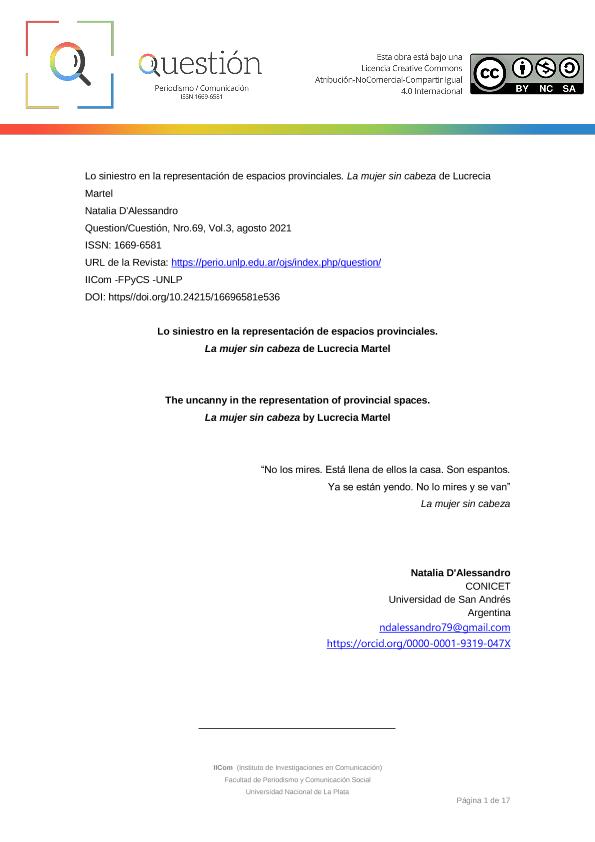Artículo
La mujer sin cabezade la directora argentina Lucrecia Martel está diseñada como “película de terror” y tiene como base un relato oral del noroeste argentino sobre las ánimas. Desde este punto de partida, me interesa indagar en la idea de “lo siniestro” en el film, siguiendo algunas propuestas del texto “Lo siniestro” de Freud. Analizaré dos aspectos de “lo siniestro” en la representación de ciertos lugares provinciales. Por un lado, propongo que la película despliega un trabajo sobre lo siniestro de ciertos mecanismos de borramiento de la historia. Estos mecanismos se perciben a través de la desmemoria sobre el accidente fundacional que abre el film y funciona como leitmotivsobre el cual gira el relato: en esos lugares del “interior” hay un énfasis en trabajar con el silencio, lo no dicho, la ausencia y el anonimato. Por otro lado, indago en la representación de espacios provinciales marcados por lo siniestro de las relaciones de poder que se entablan allí dentro. Así, propongo que la película trabaja con las ideas de “fantasma” y de lo “espectral”: hay allí voces históricamente homogeneizadas e invisibilizadas.Finalmente, me pregunto sobre la intervención de Lucrecia Martel en el campo cultural argentino en relación con la representación de estos lugares provinciales,y propongo pensar en el proyecto cinematográfico de Martel desde un interés omnipresente por ciertos conflictos contemporáneos que atraviesan diversas comunidades indígenas en distintas provincias argentinas. La mujer sin cabeza” (2008) by the Argentine director Lucrecia Martel is designed as a “horror movie” and is based on an oral story from the Argentine northwest about souls. From this starting point, I am interested in investigating the idea of "the uncanny" in the film, following some proposals from the text "The uncanny" by Freud.I will analyze two aspects of "the uncanny" in the representation of certain provincial places. Onthe one hand, I propose that the film unfolds a work on the uncanny of certain mechanisms of erasure of history. These mechanisms are perceived through the forgetfulness about the foundational accident that opens the film and functions as a leitmotif on which the story revolves: in those provincial places there is an emphasis on working with the silence, the unsaid, the absence, and the anonymity. On the other hand, I investigate the representation of provincial spaces marked by the uncanny of the power relations that are established there. Thus, I propose that the film works with the ideas of the "ghost" and the "spectral": there are historically homogenized and invisible voices there.Finally, I wonder about the intervention of Lucrecia Martel in the Argentine cultural field in relation to the representation of these provincial places, and I propose to think about Martel's film project from an omnipresent interest in certain contemporary conflicts that various indigenous communities are going through in different provinces Argentines.
Lo siniestro en la representación de ciertos espacios provinciales: La mujer sin cabeza de Lucrecia Martel
Título:
The uncanny in the representation of provincial spaces: La mujer sin cabeza by Lucrecia Martel
Fecha de publicación:
09/2021
Editorial:
Universidad Nacional de La Plata. Facultad de Periodismo y Comunicación Social. Instituto de Investigaciones en Comunicación
Revista:
Question/Cuestión
e-ISSN:
1669-6581
Idioma:
Español
Tipo de recurso:
Artículo publicado
Clasificación temática:
Resumen
Archivos asociados
Licencia
Identificadores
Colecciones
Articulos(SEDE CENTRAL)
Articulos de SEDE CENTRAL
Articulos de SEDE CENTRAL
Citación
D'alessandro, María Natalia; Lo siniestro en la representación de ciertos espacios provinciales: La mujer sin cabeza de Lucrecia Martel; Universidad Nacional de La Plata. Facultad de Periodismo y Comunicación Social. Instituto de Investigaciones en Comunicación; Question/Cuestión; 3; 69; 9-2021; 1-17
Compartir
Altmétricas




